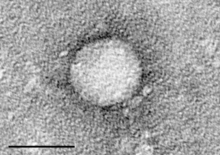
Back التهاب الكبد C Arabic হেপাটাইটিছ চি Assamese Hepatit C Azerbaijani هپاتیت سی AZB Гепатыт C Byelorussian Гепатыт С BE-X-OLD Хепатит C Bulgarian হেপাটাইটিস সি Bengali/Bangla Hepatitis C Catalan Hepatitida C Czech
| Hepatitis C | |
|---|---|
 | |
| Electron micrograph of hepatitis C virus from cell culture (scale = 50 nanometers) | |
| Specialty | Gastroenterology, infectious disease |
| Symptoms | Typically none[1] |
| Complications | Liver failure, liver cancer, esophageal and gastric varices[2] |
| Duration | Long term (80%)[1] |
| Causes | Hepatitis C virus usually spread by blood-to-blood contact[1][3] |
| Diagnostic method | Blood testing for antibodies or viral RNA[1] |
| Prevention | Sterile needles, testing donated blood[4] |
| Treatment | Medications, liver transplant[5] |
| Medication | Antivirals (sofosbuvir, simeprevir, others)[1][4] |
| Frequency | 58 million (2019)[4] |
| Deaths | 290,000 (2019)[4] |
Hepatitis C is an infectious disease caused by the hepatitis C virus (HCV) that primarily affects the liver;[2] it is a type of viral hepatitis.[6] During the initial infection period, people often have mild or no symptoms.[1] Early symptoms can include fever, dark urine, abdominal pain, and yellow tinged skin.[1] The virus persists in the liver, becoming chronic, in about 70% of those initially infected.[4] Early on, chronic infection typically has no symptoms.[1] Over many years however, it often leads to liver disease and occasionally cirrhosis.[1] In some cases, those with cirrhosis will develop serious complications such as liver failure, liver cancer, or dilated blood vessels in the esophagus and stomach.[2]
HCV is spread primarily by blood-to-blood contact associated with injection drug use, poorly sterilized medical equipment, needlestick injuries in healthcare, and transfusions.[1][3] In regions where blood screening has been implemented, the risk of contracting HCV from a transfusion has dropped substantially to less than one per two million.[1] HCV may also be spread from an infected mother to her baby during birth.[1] It is not spread through breast milk, food, water, or casual contact such as hugging, kissing, and sharing food or drinks with an infected person.[4] It is one of five known hepatitis viruses: A, B, C, D, and E.[7] Diagnosis is by blood testing to look for either antibodies to the virus or viral RNA.[1] In the United States, screening for HCV infection is recommended in all adults age 18 to 79 years old.[8] There is no vaccine against hepatitis C.[1][9] Prevention includes harm reduction efforts among people who inject drugs, testing donated blood, and treatment of people with chronic infection.[4][10] Chronic infection can be cured more than 95% of the time with antiviral medications such as sofosbuvir or simeprevir.[1][4] Peginterferon and ribavirin were earlier generation treatments that proved successful in <50% of cases and caused greater side effects.[4]: 2015 version [11] While access to the newer treatments was expensive, by 2022 prices had dropped dramatically in many countries (primarily low-income and lower-middle-income countries) due to the introduction of generic versions of medicines.[4] Those who develop cirrhosis or liver cancer may require a liver transplant.[5] Hepatitis C is one of the leading reasons for liver transplantation. However, the virus usually recurs after transplantation.[5]
An estimated 58 million people worldwide were infected with hepatitis C in 2019. Approximately 290,000 deaths from the virus, mainly from liver cancer and cirrhosis attributed to hepatitis C, also occurred in 2019.[12] The existence of hepatitis C – originally identifiable only as a type of non-A non-B hepatitis – was suggested in the 1970s and proven in 1989.[13] Hepatitis C infects only humans and chimpanzees.[14]
- ^ a b c d e f g h i j k l m n o "Q&A for Health Professionals". Viral Hepatitis. Centers for Disease Control and Prevention. Retrieved 28 September 2020.
- ^ a b c Ryan KJ, Ray CG, eds. (2004). Sherris Medical Microbiology (4th ed.). McGraw Hill. pp. 551–52. ISBN 978-0-8385-8529-0.
- ^ a b Maheshwari A, Thuluvath PJ (February 2010). "Management of acute hepatitis C". Clinics in Liver Disease. 14 (1): 169–76, x. doi:10.1016/j.cld.2009.11.007. PMID 20123448.
- ^ a b c d e f g h i j "Hepatitis C Fact sheet". WHO. 24 June 2022. Archived from the original on 31 January 2016. Updated as required.
- ^ a b c Rosen HR (June 2011). "Clinical practice. Chronic hepatitis C infection". The New England Journal of Medicine. 364 (25): 2429–38. doi:10.1056/NEJMcp1006613. PMID 21696309. S2CID 19755395.
- ^ "Hepatitis MedlinePlus". U.S. National Library of Medicine. Retrieved 2020-06-19.
- ^ "Viral Hepatitis: A through E and Beyond". National Institute of Diabetes and Digestive and Kidney Diseases. April 2012. Archived from the original on 2 February 2016. Retrieved 4 February 2016.
- ^ Cite error: The named reference
USPSTFwas invoked but never defined (see the help page). - ^ Webster DP, Klenerman P, Dusheiko GM (March 2015). "Hepatitis C". Lancet. 385 (9973): 1124–35. doi:10.1016/S0140-6736(14)62401-6. PMC 4878852. PMID 25687730.
- ^ Zelenev A, Li J, Mazhnaya A, Basu S, Altice FL (February 2018). "Hepatitis C virus treatment as prevention in an extended network of people who inject drugs in the USA: a modelling study". The Lancet. Infectious Diseases. 18 (2): 215–224. doi:10.1016/S1473-3099(17)30676-X. PMC 5860640. PMID 29153265.
- ^ Cite error: The named reference
Kim2016was invoked but never defined (see the help page). - ^ "Global progress report on HIV, viral hepatitis and sexually transmitted infections, 2021". www.who.int. Retrieved 2022-01-19.
- ^ Houghton M (November 2009). "The long and winding road leading to the identification of the hepatitis C virus". Journal of Hepatology. 51 (5): 939–48. doi:10.1016/j.jhep.2009.08.004. PMID 19781804.
- ^ Shors T (2011). Understanding viruses (2nd ed.). Burlington, MA: Jones & Bartlett Learning. p. 535. ISBN 978-0-7637-8553-6. Archived from the original on 2016-05-15.